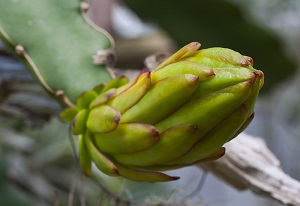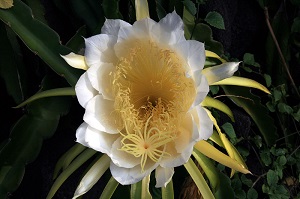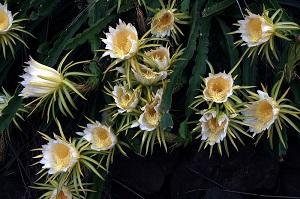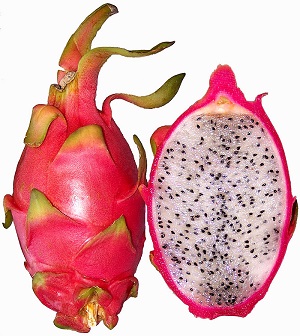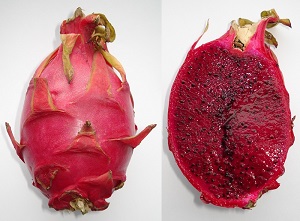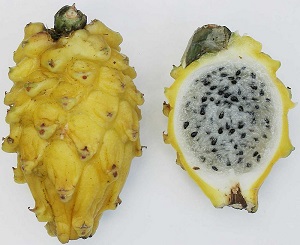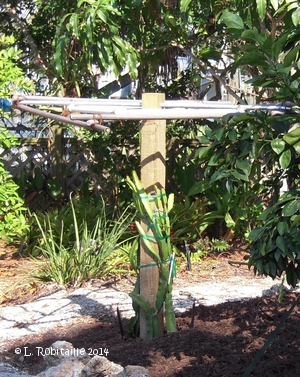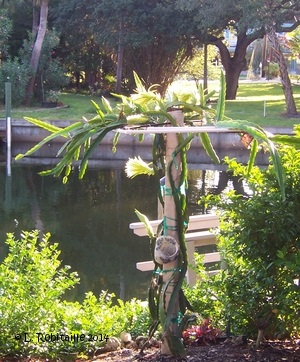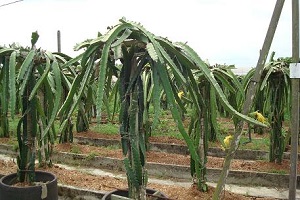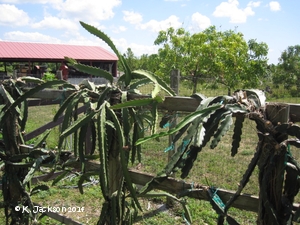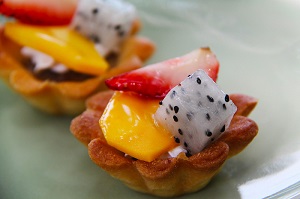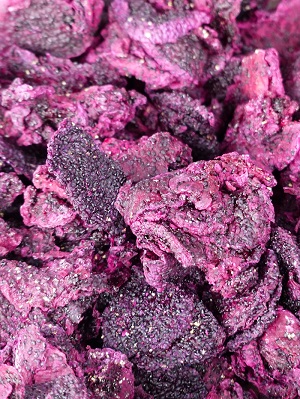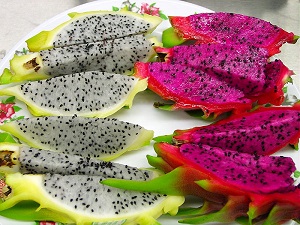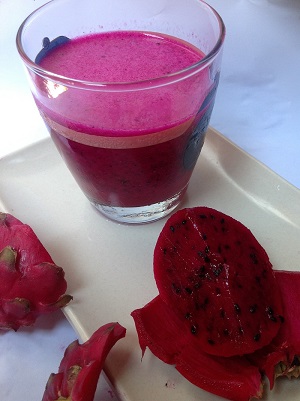| Pitaya, Dragon Fruit - Hylocereus undatus | |||||||||||||||||||||||||||||
|---|---|---|---|---|---|---|---|---|---|---|---|---|---|---|---|---|---|---|---|---|---|---|---|---|---|---|---|---|---|
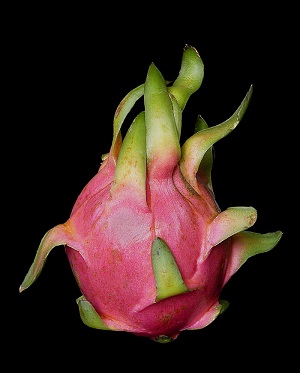 Fig. 1  Hylocereus undatus 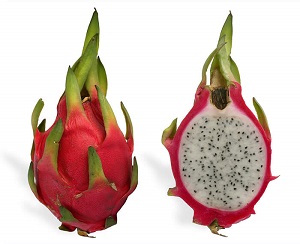 Fig. 2  Pitaya cross section 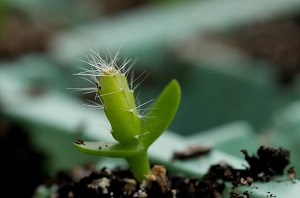 Fig. 3  Pitaya seedling 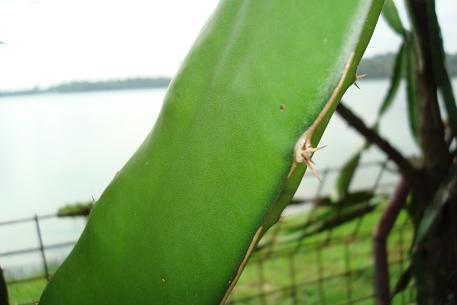 Fig. 4 Dragon fruit stem 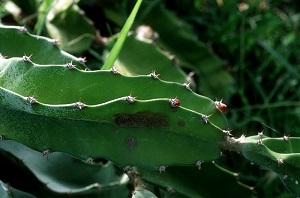 Fig. 5  Pitaya stem with two flower buds forming 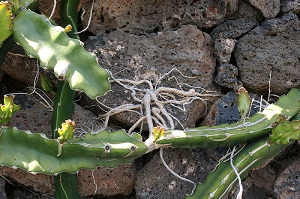 Fig. 6  H. undatus grown in the Botanical Garden “Jardin de Cactus” in Guatiza, Teguise, Lanzarote, Canary Islands 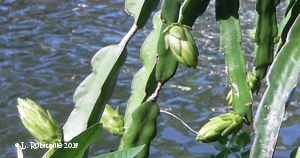 Fig. 7  Flower buds 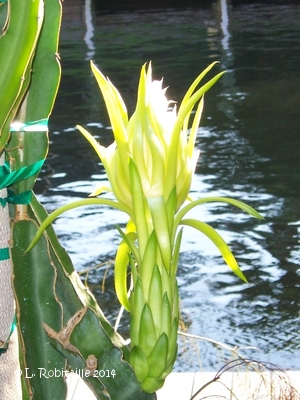 Fig. 8  Flower emerging 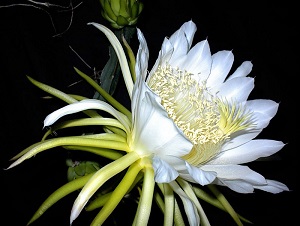 Fig. 9  H. undatus flower 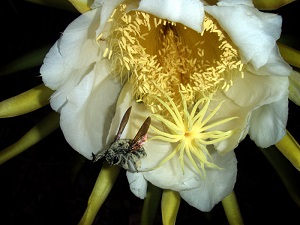 Fig. 10  Carpenter bee covered in pollen from the flower 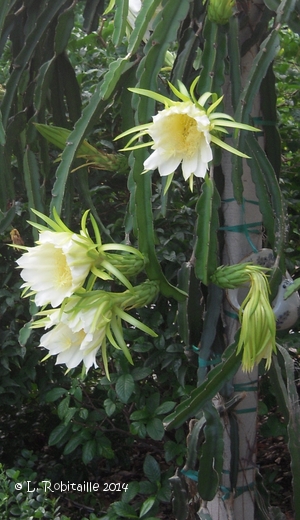 Fig. 11  Multiple flowers, one wilting 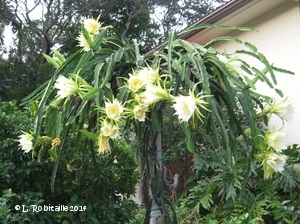 Fig. 12  Pitaya in full bloom 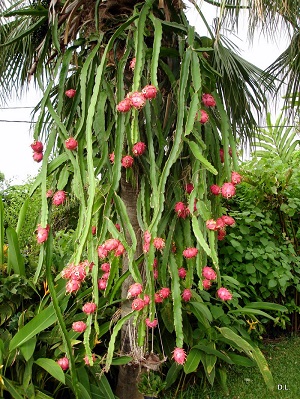 Fig. 16  Fruiting plant, climbing into a palm tree 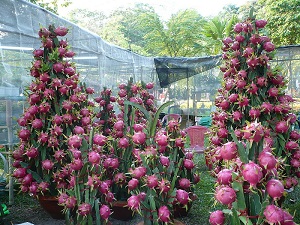 Fig. 17  H. undatus cultivated, fruiting 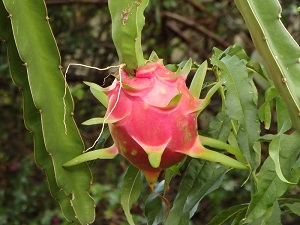 Fig. 18  H. undatus fruit 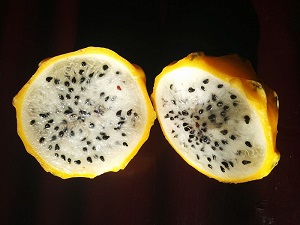 Fig. 19  H. megalanthus, yellow pitaya 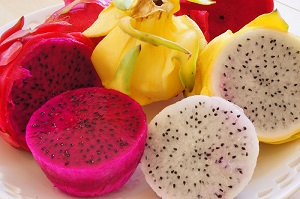 Fig. 20  H. undatus (white, pink and red) and H. megalanthus (yellow) 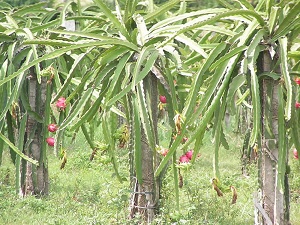 Fig. 28  Pitaya (green dragon) fruits being grown commercially in southern Vietnam 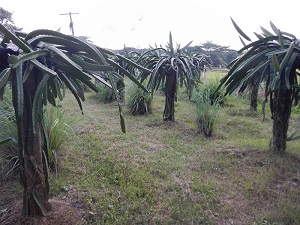 Fig. 29  Pitaya (dragon fruit) trees at the Agricultural Science and Technology School Muñoz, Nueva Ecija 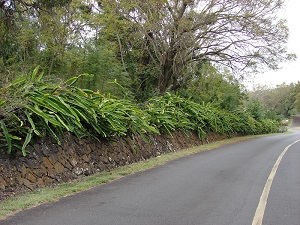 Fig. 30  H. undatus (Night-blooming cereus, paniniokapunahoa, papipi pua, dragon fruit, red pitaya). Habit. Keokea, Maui, Hawai'i. 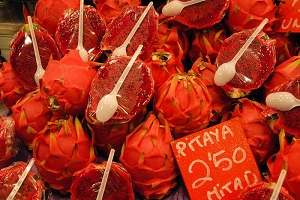 Fig. 35  Pitaya, Ciutat Vella, Barcelona, Catalonia 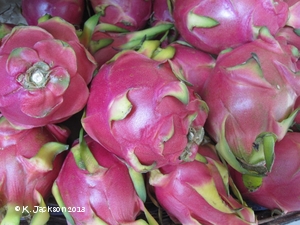 Fig. 36  Dragon fruit Dubai market 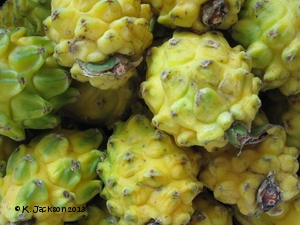 Fig. 37  H. megalanthus in Dubai market 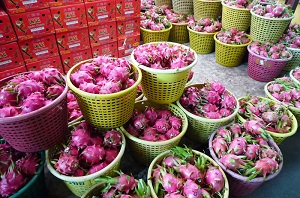 Fig. 38  Dragon fruit being prepared for Talad Thai wholesale market in Bangkok 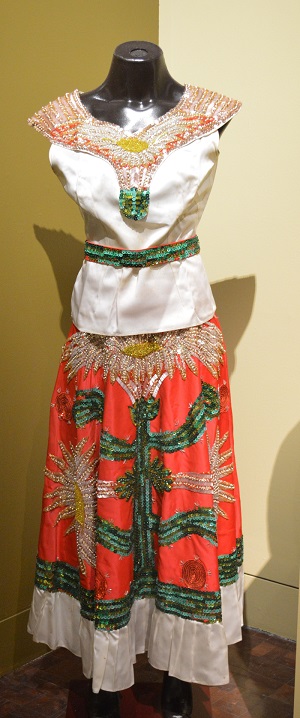 Fig. 39  Dress for a folk dance called Flor de Pitahaya "Pitahaya Flower" from Baja California Sur displayed at the Popular Art Museum in Mexico City |
Scientific
name Hylocereus undatus (Haw.) Britton & Rose Common names English: belle of the night, night-blooming cereus; pitahaya, queen of the night, red pitahaya, strawberry pear, dragon fruit; Spanish: pitahaya, tuna, nopal, pitajaya, pitahaya blanca, pitahaya dulce, pitahaya roja; French: fruit du dragon, pitahaya rouge, pitaya 8 The Spanish terms pitaya, pitajaya, pitahaya, are applied to the strawberry pear in Latin America, in common with the edible fruits of several other species of cacti; but pitahaya roja and pitahaya blanca are applied specifically to H. undatus in Mexico; pitahaya de cardón in Guatemala 5 Synonyms Cereus undatus Haw., C. guatemalensis (Eichler), C. tricostatus Rol.-Goss., C. trigonus var. guatemalensis Eichlam, C. undatus Pfeiff., C. undulatus D. Dietr., H. guatemalensis (Eichlam) Britton & Rose, H. tricostatus (Gosselin) Britton & Rose 6 Relatives Yellow pitaya (Selenicereus megalanthus), wild pitaya (H. costaricensis), pitaya (H. polyrhizus), red pitaya (H. lemairei), prickly pear (Opuntia ficus-indica), pineapple cactus (S. setaceus), night blooming cereus (C. jamacaru), queen of the night (C. hidmannianus), Peruvian apple cactus (C. repandus), Barbados gooseberry (Pereskia aculeata), Florida natives: triangle cactus (Acanthocereus tetragonus), prickly-apple cactus (Harrisia aboriginum), Indian River prickly-apple (H. fragrans), Key tree cactus (Pilosocereus polygonus) 7,12,13 Other relatives from Colombia Family Cactaceae (cactus family) Origin Tropical America: southern Mexico, Pacific side of Guatemala, Costa Rica and El Salvador; Venezuela, Colombia, Ecuador, Curacao, Panama, Brazil and Uruguay 1 USDA hardiness zones Tropical/subtropical Uses Fruit; medicinal properties Height 20 ft (6.1 m) Plant habit Vine-like cacti 1 Growth rate Fast Longevity Estimated about 20 years Trunk/bark/branches Stem segment has 3 flat, wavy wings, (ribs) with corneous margins; spines or spineless; aerial roots 1 Pruning requirement Selectively remove some stems to enhance growth and vigor of remaining stems and to induce flowering 1 Flowers Nocturnal; very large, very fragrant, bell shaped; 14 in. long (36 cm) 9 in. wide (23 cm); late spring, summer Fruit Non-climacteric; fleshy berry; oblong; 4.5 in. (11 cm); thick red or yellow peel with scales; with or without spines; pulp white, red or magenta; seeds very small, black 1 Season May-Sept. 7 Light requirement They tolerate some shade and may be injured by extreme sunlight 1 Soil tolerances Adapted to a wide range of soils provided they are well-drained 1 pH preference 5.3-6.7 Drought tolerance May withstand dry periods, they have a fairly high water requirement 1 Soil salt tolerance May tolerate saline soil conditions 1 Wind tolerance Appear to tolerate windy conditions 1 Cold tolerance May be damaged at temperatures 31°F (-2°C) of long duration; recover rapidly from light freezing injury 1 Plant spacing 15-25 ft (4.5-6.1 m) 1 Roots Superficial root system; aerial roots grow from the underside of the stems, providing anchorage for the plants to climb on 3 Invasive potential * Not considered a problem species at this time Pest/disease resistance Several important diseases attack pitayas (see below) 1 Known hazard The sap is caustic and hazardous; the plant has sharp spines 5,7 Reading Material Pitaya (Dragonfruit) Growing in the Florida Landscape, University of Florida pdf Pitaya, University of Hawai'i at Mānoa pdf The Pitaya in Florida, University of Florida, Miami Dade County pdf (Archived) Strawberry Pear, Fruits of Warm Climates Pitaya, Hylocereous undatus (Haw) - A Potential New Crop for Australia, Archives of the Rare Fruit Council of Australia The Pitaya or Dragon Fruit, West Australian Nut and Tree Crop Association Origin Tropical America; southern Mexico, Pacific side of Guatemala, Costa Rica and El Salvador; Venezuela, Colombia, Ecuador, Curacao, Panama, Brazil and Uruguay 1 Description Pitayas are fast growing, perennial, terrestrial, epiphytic, vine-like cacti. They have triangular (3-sided, sometimes 4- or 5-sided), green, fleshy, jointed, many-branched stems. Each stem segment has 3 flat, wavy wings, (ribs) with corneous margins and may have 1-3 small spines or be spineless. The stem sections of pitaya form aerial roots (Fig. 6) which adhere to the surface upon which they grow or climb. The stem may reach about 20 ft (6.1 m) long. 1 The yellow pitaya (H. megalanthus) is a smaller fruit, and is covered with many small clusters of spines, which are easily brushed off the fully ripe fruit. It is commercially grown in Colombia, has white pulp with higher sugar levels. The yellow pitaya differs remarkably in fruit characteristics and fruit development, with a fruit development time of about five months. 10 According to Dr. Jonathan Crane, a tropical fruit crop specialist at the University of Florida Homestead Research Center, dragon fruit is grown on about 721 acres in five Florida counties. These include Palm Beach, Charlotte, Brevard, Lee and Miami-Dade. 11 Flowers Flowers are hermaphroditic, however, some pitaya species and cultivars are self incompatible. The extremely showy, edible, white (pink in other species) flowers are very large, very fragrant, nocturnal, bell shaped and may be 14 inches long (36 cm) and 9 inches wide (23 cm). The stamens and lobed stigmas are cream colored. 1 Three to five spherical buttons normally emerge on the stem margins; two to three of these may develop into flower buds in about 13 days. The light green, cylindrical flower buds reach approximately 11 inches after 16–17 days, when anthesis occurs. The flowers open rapidly, starting at around 6:40-7:00 p.m., and flowering is completed by about 10:00 p.m. At 2:00 a.m., with pollination completed, the flower begins to wilt. 7
Fig. 13. H. undatus flower bud close-up, Tallinn Botanic Garden, Estonia Fig. 14. H. undatus with both carpels and stamens Fig. 15. H. undatus in bloom in Kona, Hawai'i Pollination Self-incompatibility has been reported in several cultivars available from nurseries. To increase the potential for fruit production, plant 2 or 3 different genetic types (not the same clone or variety). Cross pollination between the different types in the planting will assure a better fruit set and size. Moths and bats are good pollinators, since flowers open at night when there is no bee activity. However, moth and bat pollination has not been commonly observed. Flowers of some cultivars remain open during the early to mid-morning hours and may be visited by bees. Alternately, hand pollination may be done during the night and early morning hours by collecting pollen (or whole stamens) from one flower and applying it to the stigma of other flowers. 1 Fruit The fruit is a fleshy berry, which is oblong and about 4.5 inches (11 cm) thick with red or yellow peel with scales and with or without spines. The pulp may be white, pink, red, or magenta depending on the species. Seeds are very small, numerous, and black embedded within the pulp. 1
Fig. 21. H. undatus, white-fleshed Fig. 22. H. undatus, red-fleshed Fig. 23. H. megalanthus, yellow pitahaya fruit with spines removed Species and Varieties Pitaya fruiting for you? The Rare Fruit Club WA Harvesting In Florida, the pitaya typically fruits from May through September. An individual plant may bear more than 50 fruit per season. The fruit matures about 40 days after flowering and should not be harvested until it has achieved full coloration. 7 Propagation The pitaya is most often propagated through cuttings, obtained by severing foot-long, lateral branches at a stem segment. 7 Making a slanted cut on the stem end to be inserted into the soil is said to improve rooting. Cuttings should be cured in a cool, dry area for 5–7 days before planting. Mature stems are preferred for cuttings, as they are more resistant to insect and snail damage. Cuttings may be planted directly in the field or in pots using a well drained potting medium. 7 Planting There are two methods of planting; one is to plant a cured cutting directly into the soil. A cured cutting is one in which the cut portion of the stem has been allowed to heal (dry) for several days in the shade. 1 The second and highly recommended system is to plant the cured cuttings in pots, let them develop a good root system for 4-6 months, and then plant them in the landscape. Planting may be done any time in south Florida if an adequate provision for watering is made, otherwise, the warm, rainy season is a good time to plant. 1 There is a positive response in growth to the amount of organic matter in the soil, but highest number of roots and greatest bud number are obtained in sand. 10 Trellis For the home landscape, consider a trellis for individual plants which should consists of a post and a structure at the top of the post to support the plant. A strong trellis should be established that may withstand several hundred pounds of stem weight. A weak trellis may buckle under the weight of a mature pitaya plant. Do not use wires on the trellis because they may cut or damage the stems. If wire is used, it should be covered by hoses. 1 One to four plants can be used for each post depending on post size. A single leader stem is grown up the post, with side branches removed, until the top of the post is reached. Branches then need to hang down to flower and fruit, and training is easier at midday when the branches are soft. 10
Fig. 24,25. Support made of 4x4 in. wood post and rebars covered with pvc tubing Fig. 26. Dragon fruit structures in containers Fig. 27. Dragon fruit at Fairchild Tropical Botanical Garden Pruning Two types of pruning need to be carried out to obtain maximum production of healthy, good-quality fruits. The first one involves training the growing plants until they reach the trellis. This involves eliminating any lateral stems along the main stem until it reaches the trellis, and tying the main stem to the trellis post. Soon after plants reach the top of the trellis, their tips should be cut to induce branching. Pitaya plants are vigorous and may require pruning one to three times per year. 1 Pruning Pitaya (Dragon Fruit), Sub-Tropical Fruit Club of Qld Cultural Calendar Irrigation It is important to water your pitaya through the flowering and fruiting season at least once a week. Insolation (Sunburning) Severe stem damage has been reported from sunburn in some growing regions with low humidity or high altitude. About 30% shading is recommended during the first 3 to 4 months after planting and where insolation is at damaging levels. However, too much shade results in low production and poor quality fruit. 1 Pests/Diseases Some damage by mites, thrips, ants, scales and mealybugs, beetles, borers (Diatrea), slugs and fruit flies has been reported. Raccoons, possums, rats and birds may also cause damage to fruit and plants. Please contact your local County Cooperative Extension Agent for current control measures. 1 Stem and Fruit Canker of Dragon Fruit in South Florida, University of Florida pdf Pitaya (Dragon Fruit) (Hylocereus undatus) Pests and Beneficial Insects, University of Florida pdf Diseases Several important diseases attack pitayas. These include the bacterium Xanthomonas compestris, which causes a severe stem rot, and Dothiorella sp. and anthracnose. Severe anthracnose damage to newly planted pitaya has been observed in Florida, and anthracnose also attacks the fruits. Fusarium oxysporum has also attacked plants. Please contact your local County Cooperative Extension Agent for current control measures. 1 Food Uses The ripe strawberry pear is much appreciated, especially if chilled and cut in half so that the flesh can be eaten with a spoon. The juice is enjoyed as a cool drink. A sirup made of the whole fruit is used to color pastries and candy. The unopened flowerbud can be cooked and eaten as a vegetable. 5
Fig. 31. Chilled white flesh pitaya Fig. 32. Dried pitaya Fig. 33. H. megalanthus on the left and H. undatus on the right Fig. 34. Red dragon fruit juice Medicinal Properties ** The sap of the stems of H. undatus has been utilized as a vermifuge but it is said to be caustic and hazardous. The H. undatus fruit is noted to be useful in combating anaemia. Stems of the species are sold in homeopathy. The air-dried, powdered stems contain B-sitosterol. 5,9 General The aerial roots collect water and nutrients from their surroundings, enabling the plant to survive if the base is severed. This feature also allows the plants to be successfully grown from cuttings. 10 Further Reading Dragon Fruit: Postharvest Quality-Maintenance Guidelines, University of Hawai'i at Mānoa pdf The Red Pitaya, A New Exotic Fruit, Archives of the Rare Fruit Council of Australia Dragon Fruit Production Using Light Supplementation, Sub-tropical Fruit Club of Qld Dragon Fruit Tips, Sub-Tropical Fruit Club of Qld Thirty-one Years of Research and Development in The Vine Cacti Pitaya in Israel, Dragon Fruit Network pdf 2010 Year of the Dragon Fruit, California Rare Fruit Growers pdf Pitaya Botanical Art List of Growers and Vendors |
||||||||||||||||||||||||||||
| Bibliography 1 Crane, Johathan H., et al. "Pitaya Growing in the florida Home Landscape." Horticultural Sciences Dept., UF/IFAS Extension, HS1068, Original Pub. Nov. 2005, Revised Nov. 2016, and Dec. 2019, AskIFAS, edis.ifas.ufl.edu/HS303. Accessed 17 June 2017, 17 Mar. 2021. 2 McMahon, Gerry. "Pruning Pitaya (Dragon Fruit)." STFC Newsletter, June, July 2006, Sub-Tropical Fuit Club of Qld, stfc.org.au. Accessed 29 Apr. 2015. 3 Zee, Francis, et al. "Pitaya (Dragon Fruit, Strawberry Pear)." College of Tropical Agriculture and Human Resources, University of Hawai'i at Mānoa, Fruit and Nuts, 2004, CATHR, ctahr.hawaii.edu. Accessed 17 June 2017. 4 Crane, Jonathan, and Carlos Balerdi. "The pitaya (Hylocereus undatus and other spp.) in Florida." Horticultural Sciences Dept., UF/IFAS Extension, miami-dade.ifas.ufl.edu. Accessed 17 June 2017. 5 Fruits of Warm Climates. Julia F. Morton, Miami, 1987. 6 "Hylocereus undatus (Haw.) Britton & Rose synonyms." The Plant List (2013), Version 1.1, www.theplantlist.org. Accessed 18 June 2017. 7 Boning, Charles R. Florida's Best Fruiting Plants- Native and Exotic Trees, Shrubs, and Vines. Sarasota, Pineapple Press, 2006. 8 "Hylocereus undatus." Centre for Agriculture and Biosciences International, cabi.org. Accessed 19 June 2017. 9 Jacobs, Dimitry. "Pitaya, Hylocereous undatus (Haw) - A Potential New Crop for Australia." Dept. of Agronomy, Wageningen Agricultural University, Wageningen, The Netherlands, Feb. 1998, Archives of the Rare Fruit Council of Australia, rfcarchives.org.au. Accessed 19 June 2017. 10 Luders, Lana. "The Pitaya or Dragon Fruit." Primary Industry and Fisheries, Northern Territory of Australia, WANATCA Yearbook 25, 2001, West Australian Nut and Tree Crop Association, Wayback, wayback.archive-it.org/1941/20100524190020/http://www.wanatca.org.au/Q-Yearbook/Y25all.pdf. Accessed 1 Apr. 2021. 11 "Cautionary Tale: UF/IFAS Scientists Provide Insight Regarding Dragon Fruit." VSCNews, Vegetable and Specialty Drop News, 15 Feb. 2021, vscnews.com/uf-scientists-dragon-fruit-insects/. Accessed 1 Apr. 2021. 12 Lorenzi, Harri, et al. Brazillian Fruits & Cultivated Exotics (for consuming in natura). Nova Odessa, Instituto Plantarum de Estudos da Flora, 2006. 13 Lorenzi, Harri. Brazilian Trees, A Guide to the Identification and Cultivation of Brazilian Native Trees. Vol. 3. Nova Odessa, Instituto Plantarum de Estudos da Flora, 2009. Photographs Fig. 1 Jamain. "Pitaya, picture taken in Belgium." Wikimedia Commons, 2012, (CC BY-SA 3.0), commons.wikimedia.org. Accessed 20 June 2017. Fig. 2 SMasters. "Cross section of a ripe white pitahaya." Wikipedia, 2010, wikipedia.org. Accessed 8 Aug. 2014. Fig. 3 Bowland, Grahame. "Pitaya Seedling." Wikipedia, 2011, wikipedia.org. Accessed 8 Aug. 2014. Fig. 4,7,8,11,12,24,25 Robitaille, Liette. "Dragon Fruit Series." www.growables.org. Fig. 5 Acevedo-Rodriguez, P. "Hylocereus undatus (Cactaceae)." Smithsonian National Museum of Natural History, Department of Botany, collections.nmnh.si.edu. Accessed 10 Aug. 2014. Fig. 6 Vincentz, Frank. "Hylocereus undatus grown in the Botanical Garden “Jardin de Cactus” in Guatiza, Teguise, Lanzarote, Canary Islands." Wikipedia, 2011, (CC BY-SA 3.0), wikipedia.org. Accessed 20 June 2017. Fig. 9 Eliasson, Ulf. "Hylocereus undatus." Wikimedia Commons, 2003, (CC BY 2.5), commons.wikimedia.org. Accessed 20 June 2017. Fig. 10 Inaglory, Brocken. "Carpenter bee covered in pollen from the flower." Tropical Plants Database, (CC BY-SA 3.0), tropical.theferns.info. Accessed 20 June 2017. Fig. 13 Delso, Diego. "Hylocereus undatus, Tallinn Botanic Garden, Estonia." Wikipedia, 2012, (CC BY-SA 3.0), wikipedia.org. Accessed 20 June 2017. Fig. 14 Inaglory, Brocken. "Hylocereus undatus with both carpels and stamens." Wikimedia Commons, 2008, (CC BY-SA 3.0), commons.wikimedia.org. Accessed 20 June 2017. Fig. 15 Inaglory, Brocken. "Hylocereus undatus in bloom in Kona, Hawai'i." Wikipedia, 2008, (CC BY-SA 3.0), wikipedia.org. Accessed 20 June 2017. Fig. 16 Tominiko974. "Fruiting plant, climbing into a palm tree." Tropical Plants Database, (CC BY-SA 3.0), tropical.theferns.info. Accessed 20 June 2017. Fig. 17 Prenn. "Hylocereus undatus cultivated, fruiting." Wikimedia Commons, 2009, (CC BY-SA 3.0), commons.wikimedia.org. Accessed 21 June 2017. Fig. 18 Sample, Jane. "Dragon fruit." Flickr, 2015, flickr.com. Accessed 20 June 2017. Fig. 19 Editorenbici. "Fotografía de una pitahaya." Wikimedia Commons, 1969, (CC BY-SA 3.0), commons.wikimedia.org. Accessed 21 June 2017. Fig. 20 Roei, tabak. "Pitaya fruit in various colors." Wikipedia, 2016, wikipedia.org. (CC BY-SA 4.0). Accessed 20 June 2017. Fig. 21 Voekler, T. "Dragon fruit." Wikimedia Commons, 2008, (CC BY-SA 3.0), commons.wikimedia.org. Accessed 20 June 2017. Fig. 22 Genet (Diskussion). "Hylocereus undatus fruit (it is H. megalanthus)." Wikimedia Commons, 2013, (CC BY-SA 3.0), commons.wikimedia.org. Accessed 20 June 2017. Fig. 23 Fibonacci. "Hylocereus megalanthus, yellow pitahaya fruit with spines removed." Wikipedia, 2006, (CC BY-SA 3.0), wikipedia.org. Accessed 20 June 2017. Fig. 26 Kwan. "Hylocereus undatus." Plant Observatory, 2008-2009, natureloveyou.sg. Accessed 8 Aug. 2014. Fig. 27 Jackson, Karen. "Dragon Fruit Series." Fairchild Tropical Botanical Garden, 2013, www.growables.org. Fig. 28 Nhã Lê Hoàn. "Pitaya (green dragon) fruits being grown commercially in southern Vietnam." Wikipedia, 2003, wikipedia.org. Accessed 8 Aug. 2014. Fig. 29 Velasquez, Ramon F. "Pitaya (dragon fruit) trees at the Agricultural Science and Technology School Muñoz, Nueva Ecija." Wikipedia, 2012, wikipedia.org. Accessed 8 Aug. 2014. Fig. 30 Starr, Forest, and Kim. "Hylocereus undatus (Night-blooming cereus, paniniokapunahoa, papipi pua, dragon fruit, red pitaya). Habit. Keokea, Maui, Hawai'i." Starr Environmental, 2007, (CC BY-SA 4.0), starrenvironmental.com. Accessed 20 June 2017. Fig. 31,32,33,34 "Dragon fruit." Pixabay, Public Domain, pixabay.com. Accessed 20 June 2017. Fig. 35 Ledgard, Bryan. "Pitaya. Ciutat Vella, Barcelona, Catalonia." Flickr, 2007, (CC BY 2.0), flickr.com. Accessed 20 June 2017. Fig. 36,37 Jackson, Karen. "Dragon Fruit Series." Dubai market, 2013, www.growables.org. Fig. 38 Kahane, Remi. "Dragon fruit being prepared for Talad Thai wholesale market in Bangkok." GlobalHort Image Library, 2009, Flickr, (CC BY 2.0), flickr.com. Accessed 20 June 2017. Fig. 39 AlejandroLinaresGarcia. "Dress for a folk dance called Flor de Pitahaya "Pitahaya Flower" from Baja California Sur displayed at the Popular Art Museum in Mexico City." Wikipedia, 2015, (CC BY-SA 4.0), wikipedia.org. Accessed 20 June 2017. * UF/IFAS Assessment of Non-native Plants in Florida's Natural Areas ** Information provided is not intended to be used as a guide for treatment of medical conditions. Published 8 Aug. 2014 LR. Last update 30 Sept. 2023 LR |
|||||||||||||||||||||||||||||
